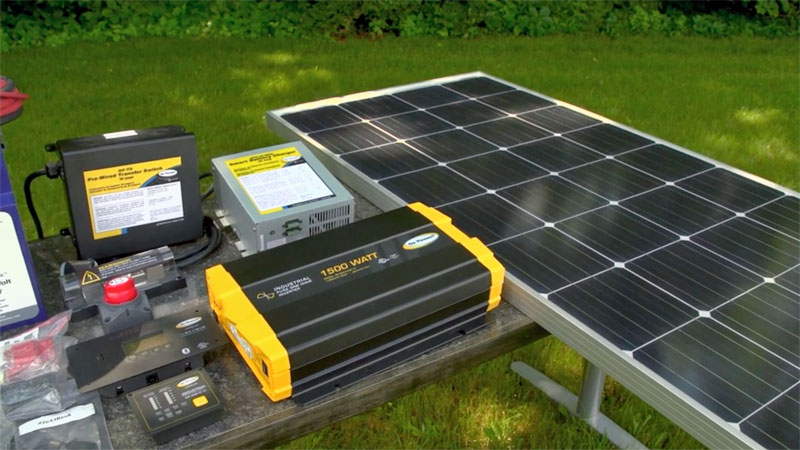rv Product Review
RV Solar System Components by Chris Dougherty of RV Enthusiast Magazine
Chris Dougherty: So boondocking with an RV has become very popular these days, and when people go out and they wanna be off the grid, they wanna be able to have the same conveniences that they’re used to when they’re hooked up to regular utilities. And so a renewable energy system for your RV is the best way to go. Now, there are a number of different ways you can do this; some RVs are coming prepped or even coming with some type of solar charging system, but what we’re gonna talk about today is how you’re gonna be able to put this in your RV, and then we’re gonna show you later on with a project that Jeff’s doing on actually installing a system in a truck camper.
So what we’ve got here are the basic components of a good renewable energy system. We start with the foundation of the system, which are your batteries, and what we have here is a lithium iron phosphate battery. Lithium is the gold standard today. This is what a lot of people are going with, and the reasons why are because you get a lot more usable power out of a lithium battery than you do with an AGM or a flooded lead acid battery. Each of these packs weighs about half the weight of a comparable flooded lead acid battery, and it lasts a lot longer. So with a lead-based battery, you get about 300 to 500 charge/discharge cycles. With these guys, you get 3,000 to 5,000 charge/discharge cycles. They’re a lot more money for an upfront purchase, but they’ll last a lot longer. You could even go from one RV to the other with it. When you go to lithium, if your RV is not already equipped, you’re gonna need a smart battery charger that you can adjust to charge lithium, and that’s what we have here from Go Power. This whole setup is from Go Power, and we’re gonna wanna make sure that we have the converter charger with the adjustments on it so that we can adjust the output.
You’re gonna have an inverter here, so we have a 1,500-watt pure sine wave inverter. You do want a pure sine wave inverter. They also make modified sine wave. Those are pretty much old-school technology, and they’re not friendly with electronics, so you wanna try to avoid that, and this will get you quite a bit of good power in your RV. And then, of course, you move up to solar. Now, a renewable energy system has to have some way of charging. Solar is the most readily available today. Couple of different types of panels out there that you’ll see, but this is pretty much what you’re gonna go with. There are some portable wind-power generators if you’re going out on the beach, out on the shore. There are some things that are available online if that’s something you want to do.
Talking about the system, we like to talk about building the foundation first. Most of this that you see in front of us here comes in a kit from Go Power. This is called the Weekender ISW Kit, and so it comes with a solar panel with a 1,500-watt inverter. Comes with a transfer switch that will automatically transfer the power from your shore power to– and generator to solar and the inverter, okay?
 And it comes with the controllers for the solar. This is a charge controller for the solar here, and this is a remote control for the inverter that you’ll install in your RV. It also comes with all the cabling and so forth that you need to install the system, and they have, in a lot of cases, have the connectors already on them. If you take a look at the back of a solar panel– and this particular one already has the solar connectors built onto the cable. You also, when you get a solar panel like this one, they have– these are the aluminum frame. They also have self-adhesive models that you glue right down to the roof of your vehicle.
And it comes with the controllers for the solar. This is a charge controller for the solar here, and this is a remote control for the inverter that you’ll install in your RV. It also comes with all the cabling and so forth that you need to install the system, and they have, in a lot of cases, have the connectors already on them. If you take a look at the back of a solar panel– and this particular one already has the solar connectors built onto the cable. You also, when you get a solar panel like this one, they have– these are the aluminum frame. They also have self-adhesive models that you glue right down to the roof of your vehicle.
When you get one of these, you’re gonna need some kind of mounting kit. And, again, with this setup, it comes with the roof brackets. So this has most of everything that you’re gonna need for the install.
A couple of things that it’s not gonna come with are gonna be sealants and some little pieces of hardware here and there, a battery shut-off switch, which is important to have so you can totally isolate the batteries when you put your camper in storage. The other thing you have to be very careful about is to make sure that you have good circuit protection, okay? And in this kit, again, they do give you a fuse kit that’s sized for this system. But, again, with a lot of these systems, this is all modular equipment, so you can pick and choose what you want, and you can add to it as time goes on. This comes back again to being– you know, planning your system out ahead of time, and that’s one of the biggest tips that we’ve got is that you wanna plan your system out on paper: How much cable run do you need, where do you need it to go, and what pieces are you going to need? Build the foundation up properly ahead of time.
So, let’s say you can’t afford or you don’t want to spend the money on a huge system right off the bat, but you think later on, “Jeez, I may have additional needs for additional solar power, more batteries, more availability.” Build your foundation up first, so make sure your cabling is built to allow you to expand the system. That way you’re not gonna have to remove wiring and replace it, because there’s a lot of work and a lot of expense in that. So upsize your cables. Make sure that you’ve got that. And then, again, with modularity, if you’re gonna do lithium or you’re gonna start with these packs, these are very expensive. So these run about $1,200 a pack, depending on the manufacturer. This one’s from Battle Born. So you may wanna start with one battery, but you can increase that bank as time goes on. This is where your power is going to come from.
So, again, if you upsize your cable, you’ll be good to go. When you go to get your inverter, again, try to predict the size of the system you’re gonna want, and get the size inverter you need right up front. So, a lot of people ask, “Where can I get a system like this if my RV doesn’t come with it?” Well, there are a number of different sources that you can use. First of all, of course, is your local RV dealer, and most RV dealers these days are installing these systems. They’re able to source this kind of product very easily. You can also, if you’re going to, again, install your own system, you can purchase a lot of this equipment online. In fact, all of it, you can purchase online and have shipped directly to you. And then there are also specialty solar installers at different parts of the country
that will build a custom system. So if you have a larger RV or your needs are a lot greater, you know, for longer amounts of time off the grid, these guys will do those installs for you, and you can just do a search online and–to find sources for that kind of equipment. So when you have a system like this, you’re gonna have lots of time off the grid and be able to really enjoy the outdoors and still have the conveniences of home.


